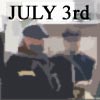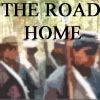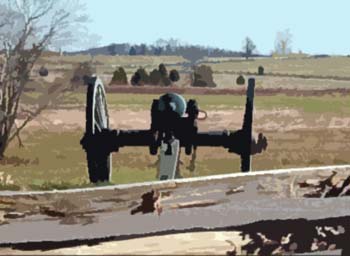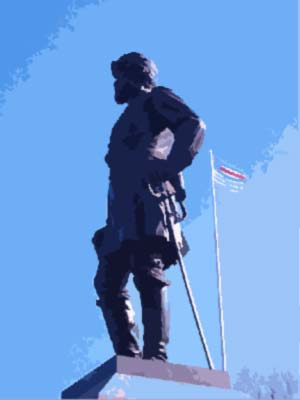






Early Movements ---
The Opening Shot ---
Reynolds Arrives ---
The Legend of John Burns ---
Reynolds' Lost Love ---
But for a Newspaper ---
The Barlow-Gordon Incident ---
The Union Falls Back ---
A Missed Opportunity for the Confederacy
Early Movements
Reynolds' Lost Love --- But for a Newspaper --- The Barlow-Gordon Incident ---
The Union Falls Back --- A Missed Opportunity for the Confederacy
Early Movements
At approximately 4 a.m. on the morning of July 1st, 1863, General John F. Reynolds, stationed some six miles east of Gettysburg, received a dispatch from General Meade. Confederate troops were in the vicinity of that small village, and the main enemy army was expected to be not far behind. Reynolds had been given command of the Union army's left wing, consisting of his own I Corps (with Abner Doubleday given temporary command), III Corps (under Daniel Sickles) and XI Corps (Oliver O. Howard commanding), a force of 30 000 men. Reynolds was to move I Corps into Gettysburg, using the rest of his wing as support. Reynolds immediately dispatched his troops towards Gettysburg with the first units en route by 8 a.m.
 At around 5:00 that morning, Confederate General Harry Heth's division, numbering between 7500-8000 men began to move down the Chambersburg Pike towards Gettysburg. Heth's division consisted of four brigades led by James Archer, Joseph Davis, John M. Brockenbrough and James J. Pettigrew, supported by two artillery battalions commanded by Majors William Pegram and David McIntosh. The popular legend is that Heth's troops were en route to Gettysburg simply to acquire some much-needed shoes. Few expected any form of major engagement.
At around 5:00 that morning, Confederate General Harry Heth's division, numbering between 7500-8000 men began to move down the Chambersburg Pike towards Gettysburg. Heth's division consisted of four brigades led by James Archer, Joseph Davis, John M. Brockenbrough and James J. Pettigrew, supported by two artillery battalions commanded by Majors William Pegram and David McIntosh. The popular legend is that Heth's troops were en route to Gettysburg simply to acquire some much-needed shoes. Few expected any form of major engagement.
Brigadier General James Archer, born in the border state of Maryland and fighting for the Confederacy, commanded the lead brigade comprised of troops from Alabama and Tennessee that headed towards Gettysburg in the rainy dawn that July morning. They were expecting to meet minimal resistance from local militia, nothing more. They marched four abreast, standard formation for road movement.
At the time, the only Federal unit in Gettysburg was Brigadier General John Buford's single cavalry division. A veteran cavalry officer with a tough-as-nails reputation, Buford realized the importance of holding the high ground afforded by McPherson's Ridge west of the town. He deployed his troops, confident that he could hold until the rest of the army arrived. Reynolds sent a courier to Buford, stating that the cavalry should hold the ground as long as possible, in essence decreeing that the coming battle would be fought at Gettysburg. Meanwhile, Reynolds ordered I Corps to get to Gettysburg with as much speed as possible. As Archer's troops continued their march, Lt. Marcellus E. Jones, of the 8th Illinois Cavalry Regiment, borrowed a carbine from Sgt. L.S. Shafer, and fired the first shot of the battle. Jones and Shafer were part of Buford's advanced pickets. After firing a few stray shots, they fell back to the main Union lines, where four squadrons of dismounted cavalrymen (under Colonel William Gamble) were strung out along McPherson's Ridge.
Archer's brigade (1100 men) and that of Joseph Davis, the nephew of Confederate president Jefferson Davis, (1700 men) formed a battle line with Davis on the left and to the north of the Chambersburg Pike, and Archer on the right and to the south of the pike. Pettigrew and Brockenbrough's brigades came up in reserve. The maneuver of so many men took time, but by 8:00, the Confederates had begun to advance against the Union cavalry, at first simply to probe the strength of the opposition.
Confederate artillery, set up on Herr Ridge, opened up on the Union horsemen. One of the shells struck Private John Weaver of the 3rd Indiana Cavalry, killing him. Weaver would be the first of many Union casualties over the next three days. The first Confederate casualty was Henry Raison of the 7th Tennessee, who had fallen as the Rebel advance began.
For the next two hours, the Union cavalry was able to hold off the combined strength of Archer and Davis's brigades. Although they were outnumbered two to one, the Union had the advantage of using quick-firing breech-loading carbines, while the Confederates still used single-shot muzzleloaders. Flanked by 1200 cavalrymen under Colonel Thomas Devin, Gamble's troops were also supported by the six 3-inch guns of Lieutenant John H. Calef's Battery A, 2d U.S. Artillery. Buford had ordered the guns seperated, with four guns on McPherson's Ridge near the Chambersburg Pike and the remaining two further down the Union line, near McPherson's Woods. Buford hoped this tactic would give the Confederates the impression that they were facing a much larger artillery presence than actually was the case.
Meanwhile, Reynolds had ridden ahead of his Federal columns, meeting with Buford at the latter's headquarters at the Lutheran Theological Seminary. When Reynolds asked for Buford's summary of the situation, the cavalry commander replied, "The devil's to pay!" The Rebels, deployed on either side of the Cashtown Pike, were preparing to overwhelm Buford's troops. The cavalrymen were running out of ammunition, and the Confederate line was a mile and a half-long, flanking the Federal positions.
Reynolds immediately called up the lead elements of the I Corps. This force included 6 brigades of infantry and 5 batteries of artillery -over 8,000 men all told- and was only three miles away. Reynold then sent a message to Meade, informing him of the situation, and vowing to fight the Confederates inch by inch. Brigadier General Lysander Cyler's brigade (of General James Wadsworth's 1st Division) and James A. Hall's Maine Battery arrived on the field at approximately 10 a.m. and moved into position behind MacPherson's Ridge, taking cover in an unfinished railway cut just as the Confederates began their attack.
The next unit on the field was Solomon Meredith's famed "Iron Brigade”. Consisting of volunteers from Indiana, Michigan and Wisconsin, the "Iron Brigade" wore long frock coats and tall black hats like members of the Regular Army. They had established a reputation as tenacious fighters. When Archer formed his attack, expecting to easily push back the tired, outnumbered cavalry, he was dismayed when someone cried,"There are those damned black-hatted fellows again. It's the Army of the Potomac."
The Iron Brigade found its numbers increased by one during its fight at Gettysburg. John L. Burns was a cobbler and a former town constable in Gettysburg. In his 70s, and a veteran of the War of 1812 and the Mexican War, Burns did not hide, as many residents did, as the battle raged. Clad in a top hat, swallowtail coat and yellow vest, Burns obtained a rifle (either his own or one he borrowed from a wounded Union soldier) and presented himself to Colonel Langhorne Wister of the 150th Pennsylvania, asking to join the fight.
Wister directed Burns to Meredith's "Iron Brigade" who were in a more sheltered position. Although he took some good-natured kidding from the men of the 7th Wisconsin Regiment, Burns proved his worth, handling a rifle with the best of them and even shooting a Confederate officer from his horse.
During the morning's fighting, Burns was wounded three times, hit in the side, leg and arm and, at least temporarily, fell into Confederate hands, who eventually allowed him to return to his home with no further harm. Word of Burns' heroics quickly spread, and when Abraham Lincoln came to Gettysburg in November, he asked to meet with the brave gentleman.
John Burns lived until February 4, 1872. In 1903, on the 40th anniversary of the battle, a stature was dedicated to him by the Commonwealth of Pennsylvania.
 Even with the newly arrived units, the Confederates attempted to flank the Union position and, outnumbered, some Federal units began to waiver. Reynolds rushed to the scene to encourage his troops. Urging his men "Forward, for God sake's forward", Reynolds fell, struck by either a stray shot or a sharpshooter's bullet and killed instantly at just after 10:15 a.m. on the first morning of battle.
Even with the newly arrived units, the Confederates attempted to flank the Union position and, outnumbered, some Federal units began to waiver. Reynolds rushed to the scene to encourage his troops. Urging his men "Forward, for God sake's forward", Reynolds fell, struck by either a stray shot or a sharpshooter's bullet and killed instantly at just after 10:15 a.m. on the first morning of battle.
Reynolds' death was not in vain, however. Abner Doubleday (who would later be erroneously credited with inventing the game of baseball) took temporary command of the field to meet the Confederate advance and soon repulsed the attack. As his men fell back, General Archer found himself captured at the hands of Private Patrick Mahoney of the 2nd Wisconsin, becoming the first Confederate general captured since Lee had taken command of the army in 1862. The survivors fled back down the slope and across the creek at its foot. Other Confederate units had little better luck. After the 55th North Carolina Brigade outflanked and drove off one of Cutler's New York Regiments, a general advance by the rest of Davis' troops was stopped by two other Union regiments with help from the 6th Wisconsin of the Iron Brigade.
Reynolds' Lost Love
When John Fulton Reynolds rode into battle that July morning, he carried with him not only the responsibility of commanding the left wing of the Army of the Potomac, but the love of a woman named Catherine Mary "Kate" Hewitt.
Born in Lancaster, Pennsylvania (just 50 miles from Gettysburg), Reynolds had seen action in Mexico, the Seminole Wars and had been posted to California. Upon his return from the West in the summer of 1860, Reynolds had a chance meeting with Hewitt and the two fell madly in love.
The trouble was that Hewitt was a Catholic and Reynolds was Protestant, and he was unsure how his family would react. The two kept their relationship a secret, but Reynolds wore her ring around his neck under his uniform.
In June, 1863, Reynolds returned to Pennsylvania to help organize militia troops for the defense of his home state. While there, he made plans to introduce Kate to his family in a couple of weeks. The two were determined to marry and honeymoon in Europe just as soon as the war ended.
Fate however, would intervene. Offered command of the Army of the Potomac by Abraham Lincoln, Reynolds declined, knowing that he would never be given a free hand. When a former subordinate, George Meade, filled the role instead, Reynolds gave Meade his whole-hearted support.
Sources vary as to the source of the shot that killed Reynolds. 16-year-old Benjamin Thorpe, of the 55th N.C. Infantry, laid claim to the shot, but stated that he was "genuinely sorry" for doing so. Others believe that it was simply a stray shot from a volley exchanged between Archer's 7th Tennessee and the 2nd Wisconsin.

By 11 a.m., a lull had developed across the battlefield. The units involved in the morning's fighting had suffered tremendous casualties. Half of Heth's division had been destroyed as neither Archer nor Davis's brigades would be able to contribute to the afternoon's fighting. Both sides took advantage of this respite to reorganize and reinforce. Dorsey Pender's division arrived to put four fresh brigades into the Confederate line and Richard Rodes' division from Ewell's Corps contributed another five brigades. By the time fighting resumed in mid-afternoon, the Confederates enjoyed a rare advantage in numbers, as they had 24 000 men on the field to the Union's 15 000.
The remaining brigades of I Corps came up to strengthen the Union forces, as did XI Corps, consisting of 10,700 men and twenty-six cannon. When General Oliver O. Howard arrived on the field at around noon, he informed Doubleday that, as ranking officer on the field, he was taking command. He saw the strategic importance of Cemetery Ridge, and decided to position part of his Corps on those heights. However, he received word from Buford that the Confederates were sending infantry to Oak Ridge to the north of the farthest extension of the Union right flank. Howard decided to leave a division and two batteries in reserve to hold Cemetery Hill, and sent the rest to Oak Ridge.
Howard's XI Corps, consisting of men from New York, Ohio and Pennsylvania, not to mention a large number of German immigrants, had gained an unwanted reputation at Chancellorsville by fleeing from the field. They would do it again at Gettysburg.
XI Corps formed a line at the right angle of I Corps positions, north of the town before Oak Ridge. However, XI Corps did not connect to the I Corps, leaving both flanks exposed. The movement of XI Corps was done under fire from the sixteen cannon of Colonel Thomas Carter's artillery battalion and Rebel skirmishers from Rodes' division.
Just after 2:00, Rodes called for a full-scale attack on I Corps northern-most positions. The attack went wrong right from the outset. Advancing without skirmishers, two brigades from Rodes' division, under Alfred Iverson and Edward O'Niel, were surprised when a brigade of the I Corps rose from behind a stone wall and poured a deadly fire into their lines. Within minutes, over half of the Confederates became casualties. The two brigades were summarily smashed and driven from the field.
Meanwhile, General Dole's four Georgia brigades from Rodes' division attacked at the west end of XI's Corps line. They gained little advantage until about 2:30 p.m., when another Georgia brigade, this one from Early's division and commanded by John Gordon, attacked the east end of the XIth Corps' line, followed by Colonel Isaac Avery's North Carolina Brigade and General Harry Hayes' Louisiana brigade. Outflanked, the XIth Corps crumbled and the entire Union line gave way.
At the north end of the I Corps line, General Gabriel Paul's brigade, having just entered the line to relieve the spent troops of Henry Baxter's brigade, found themselves under attack from Stephen Ramseur's North Carolina brigade and Doles' Georgia troops in the rear. (Doles' troops, after driving off XI Corps, had turned their attention to I Corps.) Caught in a deadly crossfire, two-third of Paul's troops became casualties. Paul himself was shot through the head and blinded. Harry Heth himself was a casualty of the battle, but his life was saved because of his new hat. He had acquired the hat in Cashtown just a few days prior. However, the hat was too big for him, so an enterprising quartermaster clerk had stuffed paper inside the brim. As the battle raged, Heth was struck in the head with a minie ball, which passed through both the hat and the paper inside. That had slowed the ball down enough so that, while it penetrated the General's skull, it did no serious damage. However, the blow to the head was enough that Heth fell senseless and lay unconscious for the next 24 hours. He suffered a concussion but survived the wound.
Robert E. Lee had arrived on the battlefield around noon. At first, he was upset about having stumbled into a battle and did not wish to turn this "chance encounter" into a full-scale engagement. As the battle wore on, he realized that the Confederates had an excellent opportunity to destroy a large portion of the Federal army. He quickly called for Heth to send in his reserves, under Pettigrew and Brockenbrough, against the Union lines along McPherson's Ridge
Brockenbrough's Viriginians and Junius Daniel's North Carolinia brigade battled the Pennsylvanian troops that held the center of the line. Pettigrew's brigade (at a strength of 2,600 men, it was the largest in the Army of Northern Virginia) and the remnants of Archer's brigade (now commanded by Colonel Birkett Fry of the 13th Alabama) pushed back the left flank of the Union line, defended by the Iron Brigade and Thomas Rowley's Pennsylvania brigade, with alarming losses on both sides. Eventually, Rowley's brigade was flanked by another regiment of Pettigrew's brigade. Soon the lines of I Corps, outflanked by Early's troops from the north and pressed by Heth's men, began to break as well. Throught the years following the Civil War, a poignant story began to circulate involving the wounding of Union Brigadier General Francis Barlow. The story goes that, as XI Corps fled before the Confederate onslaught, General Barlow, commanding the 1st Division, was left on the field seriously wounded. As the Confederates pushed forward, Brig. General James B. Gordon came across the fallen officer. Dismounting, Gordon tended to Barlow, offering him brandy and water. Barlow believed himself to be dying and asked Gordon to pass a message along to his wife, who was serving as a nurse in the Union army. Gordon arranged for a message to be sent to Mrs. Barlow who, under a flag of truce, crossed the lines to care for her husband. Gordon assumed that Barlow had, in fact, died, while Barlow heard of the death of a Confederate officer named Gordon and believed it to be the man who gave him aide. Twenty years passed. Barlow became a prominent lawyer while Gordon had been elected to the U.S. Senate. At a banquet in Washington, Gordon approached Barlow and asked if he was related to the Barlow who had been killed at Gettysburg. Barlow replied that he was the man and asked if Gordon was the same man who had acted as his benefactor. Gordon replied that, indeed, he was. The two men remained friends until Barlow's death in 1896.

The Barlow-Gordon Incident
The Union troops were routed and fleeing for safety. The Confederates were too exhausted to follow up, and Heth's division didn't advance past McPherson's Ridge. In essence, it was not unlike the first battle of Bull Run, where the Confederates routed the Union forces but were too spent to follow up.
As I Corps survivors reformed on Seminary Ridge supported by six batteries of artillery under Colonel Charles Wainwight, Hill sent in three fresh brigades from Dorsey Pender's division. In the center was Colonel Abner Perrin's South Carolina brigade, flanked by North Carolina troops under Generals James Lane and Alfred Scales.
As the Confederates advanced, they learned brutally quick that the Union forces were not quite done. Federal cannon opened fire as Scales' brigade came within 75 to 100 yards of the Union line. The blast all but destroyed Scales' brigade, killing the commander and killing or wounding all but one field officer. Lane's troops were also slowed to a halt by the withering fire from Federal infantry and cavalry. Perrin's troops, however, punched a hole in the Union center and rolled up the Federal lines. With his lines breaking, Doubleday ordered a final withdrawal from the Federal positions west of Gettysburg.
As the retreating I Corps reached Gettysburg, they collided with the fleeing XI Corps. Among the unfamiliar streets, it was there that the retreat became a route. By 4:00, the streets of Gettysburg were filled with retreating Union soldiers, who sought shelter in the town or fled to the heights of Cemetery Hill. Early's troops pursued them as far as Gettysburg, capturing thousands of unfortunate Union troops. But it would be Perrin's 1st South Carolina (of Pender's Division, Hills Corps) who would plant its colors in the town square, capturing Gettysburg in the name of the Confederacy
Atop Cemetery Hill awaited fresh Union troops and massed guns, under the leadership of General Winfield Scott Hancock, commander of the II Corps. Meade had sent Hancock to the field to take command. There was a short exchange with Howard as to who was the rightful commander of the field. The argument ended as the first troops began to fall back from Gettysburg. Hancock chose Colonel Orland Smith's brigade as a rallying point and began to assemble the retreating Federal troops. Two divisions from Doubleday's I Corps formed a line along Cemetery Hill, and a third (Wadsworth's) was sent to Culp's Hill. XI Corps was to hold East Cemetery Hill, with Buford's cavalry forming along the Emmitsburg Road, so as to protect the far-left flank. By late afternoon, Union troops had regrouped south of Gettysburg along Cemetery Hill and Hancock had sent a message to Meade, telling of his confidence that he could hold the position. That opinion was strengthened as Henry Slocum's XII Corps and elements of Daniel Sickles' III Corps began to arrive on the field between 5:00 and 6:00. Slocum, the senior officer, took command while Hancock tended to his own II Corps, which would arrive by nightfall, taking up positions near the Round Tops, a short distance from Cemetery Hill.

A Missed Opportunity for the Confederacy
Shortly after the Union troops had fallen back through Gettysburg, Lee had noticed the movement of Union troops along Cemetery Hill and Cemetery Ridge. He realized that the position would hold strategic value to the coming battle and also realized that the Union troops were not yet in such a state that they could repulse another Confederate attack. Seeing this, Lee sent word to Ewell, stating that "You only need to press those people to secure possession of the heights...Do this if possible." A vague order, to be sure, but Lee knew that Ewell's predecessor, "Stonewall" Jackson, would have taken the initiative and stormed the heights and won the day. The attack never came, however, as Ewell held back, allowing the Federals to entrench atop Cemetery Hill, and bring up reinforcements.
After the war, Lee criticized Ewell and his lack of incentive, stating that "If I had Stonewall Jackson at Gettysburg, I would have won that fight." However, in Ewell's defense, his men were probably not much better off than the Union troops he would have had to battle. Rodes' division was badly mauled and Early's troops were occupying Gettysburg. In addition, he himself was tired and bothered by infection in the stump that remained of his right leg, lost at Second Bull Run, in 1862.
By the time Ewell's third division (under Johnson) had arrived, it was nearly 8:00, too late for any attack. Johnson's only action of the day was to reconnoiter Culp's Hill to the west of Cemetery Hill and find it occupied by Wadsworth's division.
As the first day of Gettysburg ended, the Union Army of the Potomac had barely managed to avoid disaster. Because of Ewell's hesitance, they had been allowed to gain possession of the best ground in the area on which to fight. Some have argued that the Confederates had squandered their chance at a victory at Gettysburg by not pressing on and overwhelming the confused Federal forces on Cemetery Ridge and Hill.
Lee still did not know where General Stuart's cavalry was. Frantic and frustrated, he had one of his aides send search parties out to scour the Pennsylvania countryside. One of these scouts, James D. Watters, found Stuart. He was at Carlisle, where he and his men were resting after burning the army barracks there.
Atop Cemetery Hill, where the Union forces began to dig in to defend against the Confederate attacks to come, was a sign near the gateway to the cemetery for which the ridge and hill were named: "All persons found using firearms in these grounds will be prosecuted with the utmost rigor of the law."